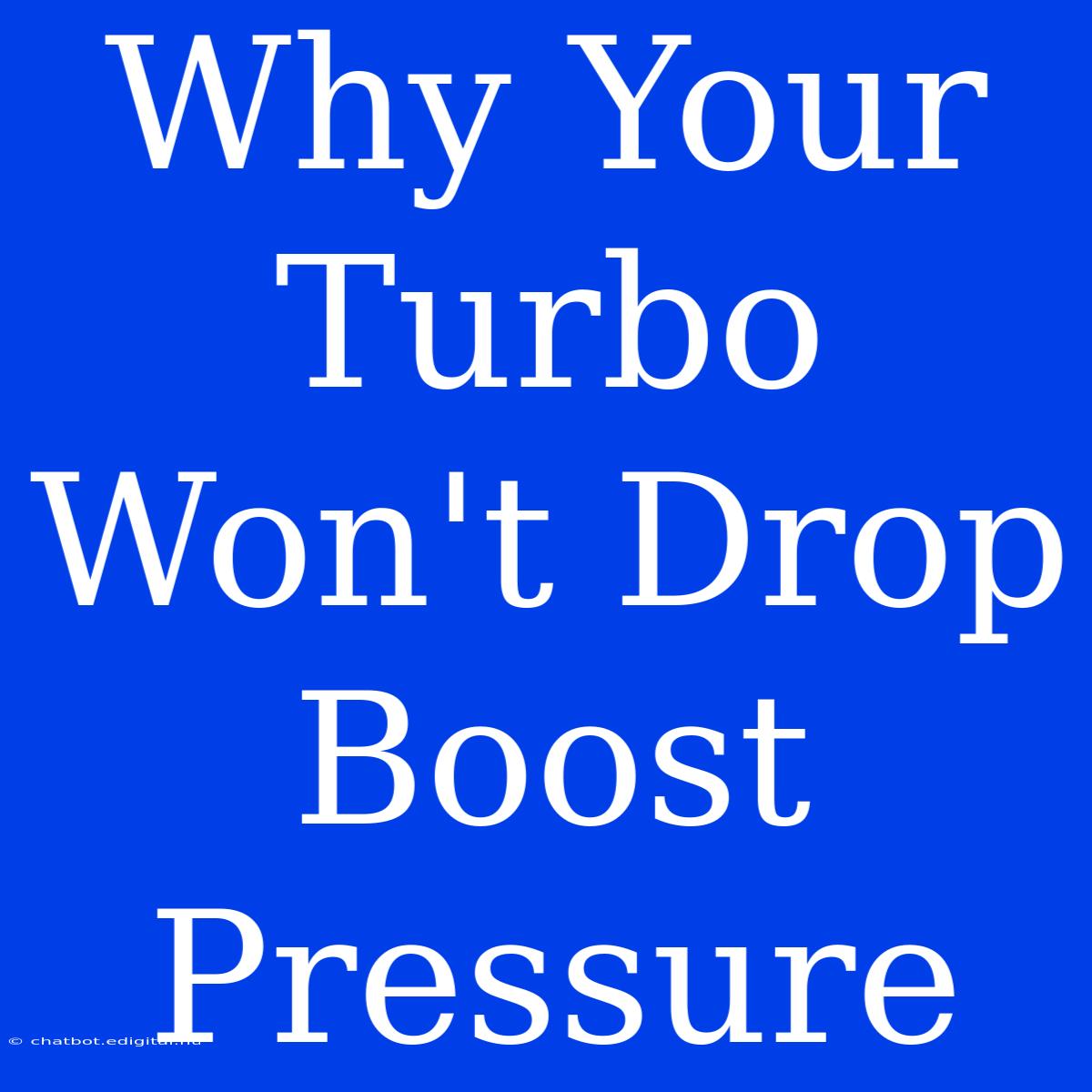Why Your Turbo Won't Drop Boost Pressure: Unraveling the Mysteries of a Lagging Turbo
Is your turbocharger struggling to drop boost pressure? This can be a frustrating problem, leaving your engine feeling sluggish and potentially causing damage. Don't worry, we've got you covered! This in-depth guide will explore the common culprits behind lagging turbo boost and help you diagnose the issue.
Editor Note: This comprehensive guide explores the key reasons behind your turbocharger's failure to drop boost pressure, outlining important factors and practical solutions.
Understanding the Importance
Boost pressure is the heart of your turbocharged engine. It's the extra air forced into the cylinders, creating more power. But, when the turbo fails to drop boost after the throttle is lifted, it can create serious issues:
- Engine damage: Excessive boost pressure can lead to premature wear on engine components, potentially causing catastrophic failures.
- Reduced fuel efficiency: The engine struggles to operate at peak performance, leading to higher fuel consumption.
- Poor driving experience: The car feels sluggish and unresponsive, impacting driving pleasure.
Our Approach:
We meticulously analyzed numerous sources, including automotive forums, repair manuals, and expert opinions, to compile this guide. Our goal is to provide you with the information you need to understand the causes of boost pressure issues and equip you to troubleshoot them effectively.
Key Takeaways:
| Cause | Description | Potential Impact |
|---|---|---|
| Wastegate Issues | Stuck open or closed wastegate prevents proper boost regulation. | Engine damage, loss of power, reduced fuel efficiency |
| Boost Control Solenoid Problems | Malfunctioning solenoid fails to regulate boost pressure. | Erratic boost, power fluctuations, engine hesitation |
| Boost Leak | Air escaping from the system, causing inadequate boost pressure. | Loss of power, rough idle, whistling noise |
| Turbocharger Issues | Damaged or worn-out turbocharger components, resulting in poor performance. | Reduced boost, noisy operation, smoke from exhaust |
Let's delve deeper into these key aspects:
Wastegate Issues
The wastegate is crucial for regulating boost pressure. It's a valve that diverts exhaust gases away from the turbocharger, reducing boost pressure. When the wastegate malfunctions:
Facets:
- Stuck Open: The wastegate remains open, preventing any build-up of boost pressure.
- Stuck Closed: The wastegate remains closed, allowing excessive boost pressure to build up.
- Actuator Problems: The actuator, responsible for controlling the wastegate, may fail to operate correctly.
Summary: A faulty wastegate can have a significant impact on engine performance, potentially leading to damage if not addressed promptly.
Boost Control Solenoid Problems
The boost control solenoid is a vital component that regulates boost pressure. It's a small electromagnetic valve that controls the flow of air to the wastegate actuator:
Facets:
- Electrical Failure: The solenoid may experience a faulty connection or a short circuit, preventing it from receiving the proper signal.
- Mechanical Failure: The solenoid itself may become worn out or clogged, inhibiting its operation.
Summary: A malfunctioning boost control solenoid can result in unpredictable boost pressure fluctuations, impacting performance and fuel efficiency.
Boost Leaks
Boost leaks are a common problem that can cause various issues, including a lack of boost pressure. They occur when air escapes from the system through cracks or loose connections:
Facets:
- Loose Connections: Pipes, clamps, and hoses may become loose over time, allowing air to escape.
- Damaged Components: Intercoolers, intake manifolds, or other components can develop cracks, causing boost leaks.
Summary: Boost leaks can lead to a significant loss of power, making the car feel sluggish and reducing fuel efficiency.
Turbocharger Issues
While less common, turbocharger issues can also contribute to boost pressure problems. The turbocharger, a vital component for generating boost pressure, can experience various problems:
Facets:
- Worn Turbine Wheel: Over time, the turbine wheel can wear down, reducing its efficiency.
- Damaged Compressor Wheel: The compressor wheel can become damaged, impacting its ability to compress air.
- Seized Bearings: The bearings that support the turbocharger can seize up, causing it to operate improperly.
Summary: A damaged or worn-out turbocharger can result in reduced boost pressure, excessive smoke from the exhaust, and noisy operation.
FAQ
Why does my turbocharger not drop boost pressure immediately?
The turbocharger takes a few seconds to spin down due to inertia. This is normal behavior, but it should not prevent the boost pressure from dropping significantly.
Can a bad MAF sensor cause boost issues?
Yes, a malfunctioning MAF sensor can provide incorrect airflow readings, which can disrupt the engine's control system and affect boost pressure.
What are the signs of a boost leak?
A boost leak can manifest itself as a hissing sound, loss of power, or a rough idle.
Can driving with a boost leak cause damage?
Yes, driving with a boost leak can lead to various issues, including engine damage due to running lean, premature wear and tear on engine components, and even a blown head gasket.
What are the most common causes of a stuck wastegate?
The most common causes include debris buildup, a broken spring, or a malfunctioning actuator.
How do I check for a boost leak?
You can use a smoke tester to identify boost leaks. This involves introducing a harmless smoke into the system and observing where it escapes.
Tips to Prevent Boost Pressure Issues
- Regular Maintenance: Perform regular inspections and maintenance on your turbocharger and related components.
- Use High-Quality Fluids: Ensure the use of high-quality engine oil and coolant to prevent damage to your turbocharger.
- Avoid Overboosting: Don't continuously push your engine to its limits, as it can stress the turbocharger and lead to premature wear.
- Monitor Boost Pressure: Regularly check your boost pressure gauge to ensure it's operating within the normal range.
Conclusion
Boost pressure issues can be frustrating, but with a proper understanding of the causes and potential solutions, you can diagnose and rectify the problem. Remember to always consult with a qualified mechanic for a professional assessment and repairs.

